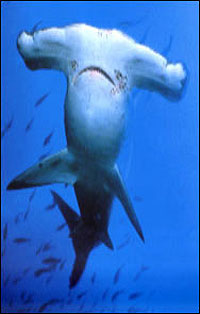Life on the reef
Linda Pitkin
Fish food: The feeding behaviour of coral fishes

Powder-blue surgeonfishes Acanthurus leucosternon graze algae on the reef. (Image: Linda Pitkin)
Some coral fishes prey on other animals; others are omnivores or herbivores. To the casual observer, plants do not appear to be much in evidence on a coral reef, but they are there in abundance as fine growth of algae or seaweed on dead corals and rock surfaces, especially in the shallows. Parrotfishes, surgeonfishes and some damselfishes graze the algae, contributing to the diversity of a coral reef by clearing new surfaces that can be used by a wide range of colonizing animals.
Coral reefs attract large predatory fishes, such as sharks and barracudas, but the numerous smaller predators are equally or even more significant. Nearly 1,000 goby species can be found on coral reefs, catching mainly shrimps, worms and other tiny bottom-living animals, while the water above the coral teems with damselfishes that eat the zooplankton suspended there. Almost all reef organisms--the coral itself and the many different invertebrate animals and fishes that the reef supports--are potential food for one or other coral fish species. Small coral fishes are preyed on by larger fishes and also by certain other reef inhabitants, among them cone shells (venomous molluscs), mantis shrimps and some starfishes.

The scalloped hammerhead shark Sphyrna lewini is an open-water species seen occasionally around reefs. It is not usually aggressive, but certain other hammerheads can be dangerous. (Image: Linda Pitkin)
Many fishes are able to feed during the day because their food--corals, seaweeds and various animals attached to the reef--is available out in the open at all times. The major coral-feeding fishes are certain butterflyfishes, but parrotfishes and other herbivores may have a major impact on the underlying corals by cropping algae. Sponges and sea squirts are eaten, particularly by the larger angelfishes, but hydroids (animals with a fern-like appearance) are usually avoided because they have stinging cells. The omnivorous scrawled filefish Aluterus scriptus--a circumtropical species--does, however, include hydroids in its diet. Fishes that feed on more active animals often wait until dusk or later, in order to pick off fishes as they scramble for night shelter or to catch crabs, octopuses and other invertebrates emerging from their holes in the reef.
Hunters
Many of the larger fishes on or around coral reefs are hunters, either of other fishes or of active invertebrates such as squid, cuttlefish, octopuses and crabs. Some hunt at night, but much of the predation on fishes takes place at dusk and dawn when smaller fishes are moving to or from their refuges and are particularly vulnerable. Strategies vary: morays and groupers remain near their places of shelter on the reef bed and capture prey that passes, while sharks and jacks chase after their victims at high speed.
Plankton-feeding: an alternative strategy
Plankton, suspended in the water above coral reefs, is an important source of nutrients and various coral fish, particularly soldierfishes, bigeyes and cardinals, specialize in using it. They are not related to each other, but many of them have similar features that relate to their lifestyle. Daytime plankton-feeders are vulnerable, especially those that swim high up in the water column where they are obvious to predators and exposed to currents, and they need to be strong swimmers.

Glasseyes Heteropriacanthus cruentatus are members of the bigeye family, which commonly feed on plankton at night. (Image: Linda Pitkin)
Typically, their small bodies are streamlined and their tails are forked to enhance propulsion. The fishes tend to gather in large numbers for safety while feeding, and all dart for shelter if a cruising predator approaches. Catching tiny, fragile plankton requires other adaptations: a small mouth without strongly developed teeth, but with jaws capable of rapid and extensive protrusion to snatch the small morsels drifting by. In some cases the action of extending the jaws creates a suction force, drawing water and particles in.
Fishes adapted for plankton-feeding may look very different to typical members of their family. This is particularly noticeable when the norm for the family is a large build, as in groupers and snappers, but less apparent when the build is generally small, as in damselfishes. Many damselfishes, particularly the numerous pullers of the genus Chromis, are planktivores. Others include basslets (the subfamily Anthiinae of the grouper and seabass family), fusiliers (related to snappers and sometimes included in that family) and certain wrasses.
Toolbox

The first collected specimen of Theobroma cacao, the plant from which chocolate is made, is kept in the Museum.